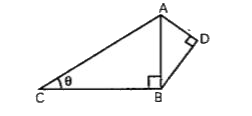In . If AD = 4 cm , DE = 12 cm and DW = 24 cm , then find the value of DB .
To solve the problem, we will use the Basic Proportionality Theorem (also known as Thales' theorem). This theorem states that if a line is drawn parallel to one side of a triangle, it divides the other two sides proportionally.
1. Identify the Triangle and Given Values:
- We have triangle ΔDEW.
- Given lengths:
- AD=4cm
- DE=12cm
- DW=24cm
- We need to find DB.
2. Apply the Basic Proportionality Theorem:
- According to the theorem, if AB∥EW, then:
ADDE=DBDW
3. Substitute the Known Values:
- Substitute the known lengths into the equation:
412=DB24
4. Simplify the Left Side:
- Simplify 412 to 13:
13=DB24
5. Cross-Multiply to Solve for DB:
- Cross-multiply to solve for DB:
1×24=3×DB
24=3×DB
6. Divide Both Sides by 3:
- To isolate DB, divide both sides by 3:
DB=243=8cm
7. Conclusion:
- The value of DB is 8cm.
Final Answer:
DB=8cm
- We have triangle ΔDEW.
- Given lengths:
- AD=4cm
- DE=12cm
- DW=24cm
- We need to find DB.
- According to the theorem, if AB∥EW, then:
ADDE=DBDW
- Substitute the known lengths into the equation:
412=DB24
- Simplify 412 to 13:
13=DB24
- Cross-multiply to solve for DB:
1×24=3×DB
24=3×DB
- To isolate DB, divide both sides by 3:
DB=243=8cm
- The value of DB is 8cm.
DB=8cm
Topper's Solved these Questions
- DIKSHA QUESTIONS BOOK - OSWAL PUBLICATIONCHAPTER - DIKSHA QUESTIONS EXERCISE - Unit -III: Coordinate Geometry (Coordinate Geometry ) (Long Answer Type Questions )
11 Videos
- DIKSHA QUESTIONS BOOK - OSWAL PUBLICATIONCHAPTER - DIKSHA QUESTIONS EXERCISE - Unit -IV: Geometry (Triangles) (Multiple Choice Questions)
8 Videos
- DIKSHA QUESTIONS BOOK - OSWAL PUBLICATIONCHAPTER - DIKSHA QUESTIONS EXERCISE - Unit -III: Coordinate Geometry (Coordinate Geometry ) (Multiple Choice Questions)
5 Videos
- COORDINATE GEOMETRYBOOK - OSWAL PUBLICATIONCHAPTER - COORDINATE GEOMETRYEXERCISE - SELF ASSESSMENT
20 Videos
- INTRODUCTION TO TRIGONOMETRY BOOK - OSWAL PUBLICATIONCHAPTER - INTRODUCTION TO TRIGONOMETRY EXERCISE - Self - Assessment
15 Videos
Similar Questions
Knowledge Check
In ΔABC DE||BC, where DE intersects AB and AC at the points D and E, respectively. If AD = 6 cm, DB = 12X- 6cm, AE= 2x cm and CE = 16 - 2x cm, then the value of X is
A6 cmB4 cmC2 cmD8 cmIn ΔABC D and E are the points on sides AB and AC, respectively, such that DE || BC. If AD = 4 cm, BC = 5 cm. DC = 10 cm and AB = 15 cm. then the sum of the lengths of DE and EC is:
AA. 20 cmBB. 15 cmCC. 21 cmDD. 18 cm
In ΔABC,DE∣∣BC so that AD==2.4cm,AE=3.2cmandEC=4.8cm, then , AB= ?

View SolutionIf ΔABC~ΔDEF, AB=4cm, DE=6,EF=9 cm and FD=12 cm, then find the perimeter of ΔABC.
View SolutionIn ΔABC,DE||BC. If AD= 4 cm, DB = 4.5cm and AE = 8cm, find AC.
View SolutionIf ΔABC~ΔDEF AB =4 cm , DE = 6 cm, EF =9 cm and FD =12 cm find the perimeter of ΔABC .
View SolutionIn △ABC, D and E are points on the sides AB and AC, respectively, such that DE || BC. If AD = 5cm, DB = 9cm AE =4cm and BC = 15.4cm, then the sum of the length of DE and EC (in cm) is:
△ABC में, D और E क्रमशः AB और AC भुजाओं पर बिंदु इस प्रकार है की DE||BC, यदि AD = 5cm, DB = 9cm AE = 4cm और BC = 15.4cm है, तो DE और EC (सेमी में) की लंबाई का योग है
View SolutionIn a △ABC, DE is parallel to BC, AD = 3 cm, AE = 4cm and AC = 10 cm, then the value of BD in centimetres, is:
△ABC में, DE, BC & समानांतर है, AD = 3 cm, AE= 4cm और AC = 10 cm, फिर BD (सेंटीमीटर में) मान है:
View Solution


